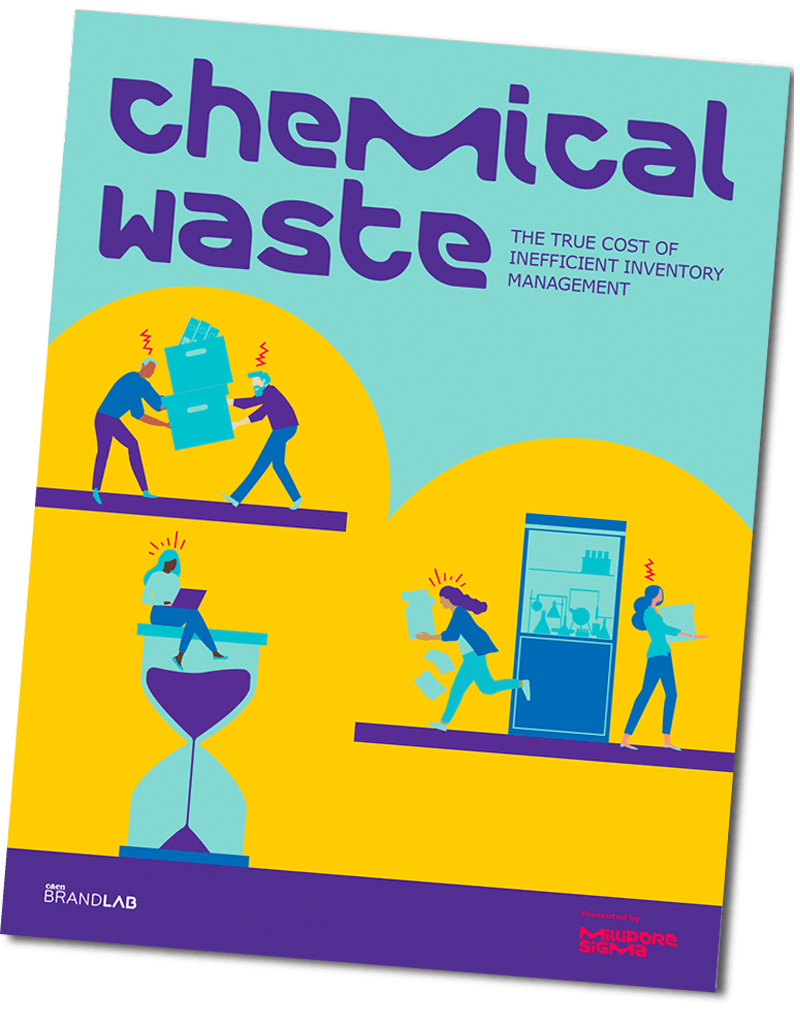Spinningyour wheels
C&EN BrandLab
M any experiments inherently take up a good chunk of the workday. But a surprising amount of additional time is spent tracking down the necessary reagents, transferring experimental data from the instruments to your workstation computer, and perhaps even converting that data to other formats to facilitate analysis. This can add hours of tedious labor to an already demanding set of tasks—but digital solutions are coming online that can help lab personnel stay squarely focused on their research.
The loss of productivity due to unnecessary expenditure of energy and effort is known generally as “motion waste.” When Japanese engineer Taiichi Ohno first described this concept in the mid-20th century, his focus was on industrial manufacturing, where needless movement on the assembly line could slow production or put workers at risk of fatigue or injury. Ohno’s ideas on efficiency have since become a core component of automaker Toyota’s famed efficiency practices, and many other industries have subsequently drawn inspiration from what has subsequently come to be known as ‘the Toyota Way’.
The concept of motion waste is directly relevant to the laboratory world as well, but it assumes different forms than on a factory floor. “One such motion waste is performing unnecessary tasks, so that there is this unused talent,” says Roja Azees, product manager at MilliporeSigma’s Connected Lab division. “They are losing their time over repetitive admin tasks rather than focusing on innovative, scientific experiments.”
And whereas each station on an assembly line can be retooled to minimize motion waste for the particular task being performed there, this is usually not an option in the research world. “Lab activities evolve over time, and you can’t spend money on redoing and restyling your labs every couple of years because you want to decrease motion waste—so you need to adapt,” says Alessandra Pepe, chemistry, manufacturing, and controls technology and innovation lead at MilliporeSigma.
Saving a trip
The solution to streamlining a laboratory’s workflow is sometimes straightforward. For instance, Pepe notes that many labs have cell culture or animal facilities that are strictly maintained under sterile conditions, requiring staff to change in and out of protective gear as they enter and leave. By ensuring that those sterile rooms have dedicated stockpiles of reagents and securely networked computers, managers can spare their teams the effort of going through unnecessary rounds of gowning up and stripping down to fetch chemicals or relay instrumental data collected in the facility back to their desktop workstations.
Addressing other forms of motion waste requires more extensive effort. Inventory management is one example; even cutting-edge research labs continue to rely on outdated, manual solutions for tracking their reagent stocks. “We used to perform all inventory counts by manually writing down what is in the cabinets and rewriting it in Excel,” says Sarah Waldenmaier, a quality control technician at MilliporeSigma. This laborious process can be done only so many times in the space of a week and creates ample opportunities for recording errors. As a result, researchers may find themselves going on a wild-goose chase, hunting throughout the lab for chemicals that don’t exist.
MilliporeSigma’s Connected Lab aims to help researchers cut down on unnecessary activities that waste time and resources. The division’s LANEXO system streamlines chemical inventory management by using reagent bottles that are tagged with radio-frequency identification and can be scanned with a smartphone-based app. This scanning process creates a real-time digital inventory of current chemical stocks, along with where those compounds are physically stored and when they expire. “With LANEXO, we could lower the time we use for inventory counts from about 32 h a year to maybe 4 h,” Waldenmaier says. “We also reduced our chemical waste and improved the timeline of the reorder process.” More importantly, the research staff could put greater trust in their recorded inventory and spend less time wandering around the laboratory and stockroom searching the shelves.
Data whenever, Wherever
Data management may seem like an unlikely cause of motion waste, but unnecessary effort at a computer can be just as much of a time sink as roaming the laboratory floor. One of the roots of this problem is that most laboratory instruments use proprietary data formats that cannot readily be integrated or compared. Azees notes that many researchers will simply copy and paste the raw data generated by various instruments into Word files or other third-party data formats for reorganization and further analysis. This extra movement creates multiple, distinct copies of the data that reside on different computers, making it a challenge if lab members need to track down and revisit older experimental data.
A universal, open-source standard known as Analytical Information Markup Language (AnIML) could solve this problem by making it easier to manage and interpolate data from diverse lab instruments, according to Connected Lab’s head of product Annette Hellbach.
Her team is developing and testing a system in which data is uploaded to the cloud as it gets collected and then is automatically converted into AniML. This creates a centralized and fully interoperable repository of research data that stays in one place with no user intervention required. “We had one customer with three labs, and overall they saved around 1,000 hours of work per year,” Hellbach says.
These software solutions are proving especially beneficial in the pandemic era, given that motion waste for off-site workers may entail an actual commute to retrieve data or check in on an experiment. Accordingly, the Connected Lab team is enthusiastic about the prospect of extending its digital toolbox to enable the monitoring and management of virtually every component of the laboratory environment. “For me, the next step would be to build out a digital map of the lab, including all the instruments, chemicals, and other materials that you need for your research,” Hellbach says.
Such a system would be a huge leap toward making laboratory motion waste a thing of the past and creating an environment where every departure from the bench is as productive as possible. For example, on-site workers could track the availability of the equipment they need for a planned experiment, saving themselves a trip to a mass spectrometer or ultracentrifuge that is already in use. Such tools could also benefit team members working remotely or running equipment overnight, so that they need only commute to the lab if a problem arises. “Then they don’t have to take night shifts to be there and guard the process in case something happens,” Pepe says. “This is another way in which technology and software can improve their life.”




